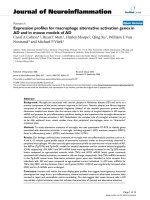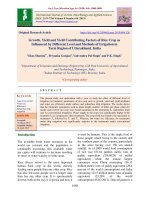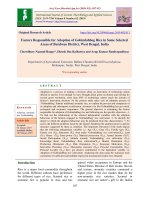Phenology, thermal indices and yield prediction models of indigenous aromatic rice of West Bengal, India
Bạn đang xem bản rút gọn của tài liệu. Xem và tải ngay bản đầy đủ của tài liệu tại đây (207.34 KB, 6 trang )
Int.J.Curr.Microbiol.App.Sci (2018) 7(3): 1645-1650
International Journal of Current Microbiology and Applied Sciences
ISSN: 2319-7706 Volume 7 Number 03 (2018)
Journal homepage:
Original Research Article
/>
Phenology, Thermal Indices and Yield Prediction Models of Indigenous
Aromatic Rice of West Bengal, India
Sibajee Banerjee1*, Mrityunjay Ghosh1* and Debasis Mazumder2
1
Department of Agronomy, 2Department of Agricultural Statistics, Bidhan Chandra Krishi
Viswavidyalaya, Mohanpur, Nadia, West Bengal, India
*Corresponding author
ABSTRACT
Keywords
Aromatic rice,
Phenology, Regression
model, Thermal
indices, Yield
Article Info
Accepted:
12 February 2018
Available Online:
10 March 2018
The phenological development and thermal unit requirements of seven aromatic rice
landraces of West Bengal were studied in randomized block design (RBD) with 3
replications at ‘C’ Block Farm (22o 99’ N, 88o 45’ E, 9.75 m.s.l.), Bidhan Chandra Krishi
Viswavidyalaya, Kalyani, West Bengal, India during kharif (wet) season of 2008 and
2009. All seven indigenous scented rice cultivars were long-duration types (140.0 – 148.3
days) and differed slightly among themselves towards attainment of different phenophases
and accumulation of heat units. Mean cultivar days from sowing to emergence, 4 th leaf
emergence, active tillering, panicle initiation, 50% flowering, milk, dough and maturity
stages were 3.9, 21.4, 47.1, 73.6, 111.3, 122.5, 133.6, 122.5, 133.6 and 144.6 days,
respectively. Mean growing degree days (GDD), heliothermal units (HTU) and
photohermal units (PTU) were 1449±83, 6473±453 and 18439±999 during vegetative
stage, 729±10, 4465±223 and 8679±167 during reproductive stage and 530±23, 4389±254
and 6035±255 during ripening stage, respectively. Based on accumulated GDD, HTU and
PTU for entire life cycle, the cultivars could be arranged as: Radhunipagal > Chinikamini
> Mohanbhog > Badshabhog > Khasdhan > Gobindabhog > Kalojira. The correlation
studies revealed that GDD and HTU at tiller production stage had positive influence on
number of panicle m-2, while HTU at ripening stage showed positive impact on grain
filling and development leading to higher grain yield. The regression model for grain yield
(Y= 3.93 – 0.0138 GDDM-D** – 0.000724 HTUM-D*) showed associations with GDD
and HTU both during milk to dough stage and accounted for 34 % variation at 1 % level of
significance.
Introduction
There are about 25-30 aromatic rice landraces
in West Bengal, which are cultivated by the
farmers in different parts of the state for
hundreds of years. It is estimated that about
3,00,000 tonnes of such premium rices are
produced every year (Bhattacharya, 2003),
which have different end-uses like cooked
table rice, dessert (payas), biriyani, etc. With
the introduction of high-yielding varieties, the
cultivation of such scented rice cultivars is
being marginalized, but they are still grown by
the farmers mainly for domestic consumption,
1645
Int.J.Curr.Microbiol.App.Sci (2018) 7(3): 1645-1650
social and religions functions. Weather
variability is considered as one of the major
factors of inter-annual variability in crop
growth and yield in all environments. In the
event of unpredictable weather conditions
during kharif season (south-west monsoon
period, June–October), agro-meteorological
indices such as growing degree days (GDD),
heliothermal units (HTU), etc. can be quite
useful in predicting the growth and yield of
these aromatic rice landraces in the region.
Thus, it is necessary to generate information
on phenological development and effects of
weather parameters on indigenous aromatic
rice as well as development of yield prediction
models for necessary refinement of production
technologies in future.
Materials and Methods
A field experiment was conducted to study the
phenological development and thermal unit
requirements of aromatic rice landraces of
West Bengal at ‘C’ Block Farm (220 5' N, 890
0' E and 9.75 m.s.l.) of Bidhan Chandra Krishi
Viswavidyalaya, Kalyani, West Bengal, India
during kharif (wet) season of 2008 and 2009.
Seven indigenous scented rice cultivars (viz.
Gobindabhog, Badshabhog, Mohanbhog,
Radhunipagal, Kalojira, Chinikamini and
Khasdhan) were transplanted in 4 m × 3 m
plots with a spacing of 15 cm × 15 cm in a
randomized block design (RBD) with 3
replications. A uniform fertilizer dose
consisting of FYM @ 5 t ha-1 as basal and
mustard cake @ 0.25 and 0.25 t ha-1 were
applied to all experimental plots at 3 and 6
weeks after transplanting.
A total of eight phenophases (viz. P1 = sowing
to emergence, P2 = emergence to 4th leaf
emergence, P3 = 4th leaf emergence to active
tillering, P4= active tillering to panicle
initiation, P5= panicle initiation to 50%
flowering, P6= 50% flowering to milk, P7=
milk to dough and P8= dough to maturity)
were studied by visiting the field at every 2-3
days intervals. Daily weather data was
collected from Agromet Observatory of
AICRP on Agrometeorology, B.C.K.V.
Centre, Kalyani, Nadia and thermal indices
were calculated by the following formulae.
Growing degree days (GDD) = [(Tmax. +
Tmin.) / 2] - 10 0C
Heliothermal units (HTU) = GDD* Bright
sunshine hour
Photothermal units (PTU) = GDD* Day length
The correlation studies between thermal
indices and yield associated characters were
made and yield prediction models were
developed for scented rice in the investigation.
Results and Discussion
Phenology
Among seven aromatic rice landraces, number
of days to maturity pooled over two years
varied between 140.0 days (Kalojira) and
148.3 days (Radhunipagal) (Table 1). So, all
the cultivars in the study were long-duration
types and the differences in growth duration
were mainly due to variation in length of
vegetative phase from 69.5 to 78.0 days. The
finding was in conformity with the opinion of
Oldeman et al., (1987). Mean cultivar days
from sowing to emergence, 4th leaf emergence,
active tillering, panicle initiation, 50%
flowering, milk, dough and maturity stages
were 3.9, 21.4, 47.1, 73.6, 111.3, 122.5, 133.6,
122.5, 133.6 and 144.6 days, respectively.
Kalojira was the earliest cultivar (68.0 and
71.0 days) to complete the vegetative stage in
both the years of experimentation; while
Badshabhog and Radhunipagal required
minimum days (37.0 days) for reproductive
stage during 2008 and 2009, respectively and
1646
Int.J.Curr.Microbiol.App.Sci (2018) 7(3): 1645-1650
Gobindabhog completed the ripening stage in
lowest number of days (32.0 and 30.3 days)
during both the years of investigation (data not
shown).
Thermal indices
Mean air temperature and bright sunshine
hours at eight phenophases were: 30.80C and
4.0 hours (sowing to emergence), 29.30C and
3.2 hours (emergence to 4th leaf emergence),
29.90C and 4.6 hours (4th leaf emergence to
active tillering), 29.50C and 5.0 hours (active
tillering to panicle initiation), 29.40C and 6.1
hours (panicle initiation to 50% flowering),
26.50C and 7.7 hours (50% flowering to milk),
25.90C and 9.1 hours (milk to dough) and
25.40C and 8.0 hours (dough to maturity).
The meteorological parameters indicated that
mean air temperature was near-plateau stage
both during vegetative and reproductive
phases, which declined in ripening phase. On
the other hand, bright sunshine hours per day
were less in vegetative stage mainly due to
cloudy weather during south-west monsoon
season, which increased progressively during
reproductive and ripening stages of rice crop.
Mean growing degree days, heliothermal units
and photohermal units were 1449±83,
6473±453 and 18439±999 during vegetative
stage, 729±10, 4465±223 and 8679±167
during reproductive stage and 530±23,
4389±254 and 6035±255 during ripening
stage, respectively (Table 2). The accumulated
GDD and HTU from emergence to maturity of
seven long-duration aromatic rice cultivars
were 2708 and 15327, respectively in the
study; which were somewhat greater than
2102 and 12031 in a medium duration variety
cv. Polasa Prabha in Hyderabad, Andhra
Pradesh (Sreenivas et al., 2010). The summed
growing degree days for entire life cycle
varied between 2628 (Kalojira) and 2759
(Radhunipagal), which could be supported by
the fact that lengthening in growth duration
(140.0 vs. 148.3 days) generally resulted in
higher amount of accumulated heat. Similar
findings on summed GDD for entire growth
duration of scented rice cultivars were
reported by Ghosh et al., (2005).
Table.1 Effect of cultivars on phenological development of indigenous aromatic rice during
kharif season (pooled over two years)
Cultivar
Gobindabhog
Badshabhog
Mohanbhog
Radhunipagal
Kalojira
Chinikamini
Khasdhan
Mean
S.Em.(±)
CD at 5%
S-E
3.5
3.8
4.0
4.5
3.2
4.0
4.0
3.9
0.42
1.24
Vegetative
E-4LE 4LE-AT
7.5
25.0
18.2
26.0
17.5
26.2
17.0
25.8
17.3
25.5
18.0
26.0
18.0
25.5
17.6
25.7
0.42
0.40
1.24
NS
AT-PI
26.5
25.0
27.5
30.7
23.5
27.8
24.8
26.5
2.39
6.96
Repro ductive
PI-F
37.8
37.5
37.7
37.2
38.0
37.8
38.0
37.7
0.13
0.39
Ripening
F-Mi Mi-D
10.5
10.5
11.5
11.5
11.2
11.0
11.0
11.2
11.0
10.8
11.2
11.2
11.2
11.8
11.1
11.1
0.13
0.15
0.39
0.45
D-M
10.2
11.0
11.2
11.0
10.7
11.3
11.2
10.9
0.14
0.42
Life cycle
S-M
141.5
144.5
146.3
148.4
140.0
147.3
144.5
144.6
0.34
0.95
S-E = sowing to emergence, E-4LE = emergence to 4th leaf emergence, 4LE-AT = 4th leaf emergence to active
tillering, AT-PI = active tillering to panicle initiation, PI-F = panicle initiation to 50% flowering,
F-Mi = 50% flowering to milk, Mi-D = milk to dough and D-M = dough to maturity and
S-M = sowing to maturity
1647
Int.J.Curr.Microbiol.App.Sci (2018) 7(3): 1645-1650
Table.2 Accumulated thermal indices at growth stages of indigenous aromatic rice
(Pooled over two years)
Cultivar
Vegetative
stage
Gobindabhog
Badshabhog
Mohanbhog
Radhunipagal
Kalojira
Chinikamini
Khasdhan
Mean
1424
1436
1476
1530
1365
1488
1423
1449
Gobindabhog
Badshabhog
Mohanbhog
Radhunipagal
Kalojira
Chni Kamini
Khasdhan
Mean
6327
6502
6616
6842
5936
6658
6427
6473
Gobindabhog
Badshabhog
Mohanbhog
Radhunipagal
Kalojira
Chinikamini
Khasdhan
18134
18282
18768
19421
17424
18922
18125
Mean
18439
Reproductive
stage
Ripening
Stage
Life cycle
509
554
528
511
525
526
554
530
2667
2714
2730
2759
2628
2743
2711
2708
4278
4627
4298
4119
4538
4241
4624
4389
15040
15400
15479
15678
14749
15568
15377
15327
5800
6310
5991
5826
6069
5961
6291
32675
33217
33403
33740
32320
33556
33166
6035
33153
Growing degree days (GDD)
734
724
726
718
738
729
734
729
Heliothermal units (HTU)
4435
4271
4565
4717
4275
4669
4326
4465
Photothermal units (PTU)
8741
8625
8644
8493
8827
8673
8750
8679
Table.3 Correlations between GDD and HTU at different growth stages and yield associated
parameters of indigenous aromatic rice
Thermal
indices at
phenophases
AT - PI
PI - F
F - Mi
Mi - D
D-M
AT - PI
PI - F
F - Mi
Mi - D
D-M
Panicle
length
No. of
panicles m-
No. of filled
grains panicle-
2
1
1000 grain
weight
Grain yield
-0.106
0.166
0.069
-0.492**
-0.072
Growing degree days (GDD)
0.348*
0.159
-0.288
0.034
-0.532**
0.101
-0.020
-0.599**
-0.330*
0.010
-0.186
0.012
-0.119
-0.141
-0.218
-0.270
0.141
-0.116
-0.395**
-0.309*
-0.339*
-0.099
0.149
-0.245
0.0474**
Heliothermal units (HTU)
0.453**
-0.303
0.581**
-0.118
-0.390
0.235
-0.024
-0.436**
0.071
0.138
0.115
0.229
-0.213
0.031
0.386*
-0.020
-0.089
-0.181
0.087
0.333*
Sample size; n = 42
r value = 0.304* and 0.393** at 5% and 1% level of significance, respectively
1648
Int.J.Curr.Microbiol.App.Sci (2018) 7(3): 1645-1650
Table.4 Multiple regression equations for prediction of yield associated characteristics and yield
of aromatic rice
Parameter
Panicle length
No. of panicles m-2
No. of filled grains panicle -1
1000 grain weight
Grain yield
Straw yield
Equation
Y = 31.08 – 0.048 GDDMi-D** + 0.0014 HTUD-M**
Y = 499.89 + 0.05 HTUPI-F** – 0.59 GDDPI-F*
Y = 224.05 – 0.66 GDDMi-D**
Y = 10.08 + 0.0004 HTUD-M*
Y = 3.93 – 0.0138 GDDMi-D** – 0.000724 HTUMi-D*
Y = 1.14 + 0.00087 HTUPI-F**
R2
0.46**
0.41*
0.36**
0.15*
0.34**
0.41**
GDDPI-F = GDD (panicle initiationto 50% flowering); GDDMi-D = GDD (milk to dough)
HTUPI-F = HTU (panicle initiation to 50% flowering); HTU Mi-D = HTU (milk to dough); HTUD-M = HTU (dough
to maturity)
The summed GDD and PTU for all seven
cultivars were slightly higher during 2009
than 2008 mainly due to longer vegetative
phase accompanied with greater air
temperature and photoperiod during the
period; while summed HTU was greater in
earlier year due to more sunshine hours
during vegetative phase than the later year of
study. Based on accumulated GDD, HTU and
PTU for entire life cycle, the cultivars could
be arranged as: Radhunipagal > Chinikamini
> Mohanbhog > Badshabhog > Khasdhan >
Gobindabhog > Kalojira.
dough to maturity stage had positive influence
(r = 0.386*) on 1000 grain weight. Grain
yield was negatively correlated with GDD at
milk to dough and dough to maturity stage,
while positively correlated with HTU during
dough to maturity stage in the study. The
regression model for grain yield (Y= 3.93 –
0.0138 GDDM-D** – 0.000724 HTUM-D*)
showed associations with GDD and HTU
both during milk to dough stage and
accounted for 34 % variation at 1 % level of
significance (Table 4). Mandal and Ghosh
(2003) reported similar yield prediction
models for hybrid rice in West Bengal.
Correlations and yield prediction models
The correlation studies revealed that GDD
influenced tiller production positively (r =
0.348*) during active tillering to panicle
initiation stage, which ultimately led to
greater number of panicles m-2 at maturity
(Table 3). But HTU during both tiller
production and panicle determination stages
(i.e. active tillering to panicle initiation and
panicle initiation to 50% flowering) had
positive influence (P < 0.01) on number of
panicles m-2 Mean bright sunshine hours
during milk to dough (9.56 vs. 8.58 hours)
and dough to maturity (8.67 vs. 7.15 hours)
were higher in 2008 than 2009, which
resulted in better grain filling and
development during earlier than later year of
investigation. Accordingly, HTU during
Aromatic rice landraces of West Bengal were
long-duration types (>140 days) and they
required mean GDD, HTU and PTU of 2708,
15327 and 33153 for entire life cycle,
respectively.
GDD and HTU at tiller production stage had
positive influence on number of panicle m-2,
while HTU at ripening stage showed positive
impact on grain filling and development
leading to higher grain yield.
Acknowledgement
The authors are thankful to Sri Kitab Ali
Mandal, Sri Nirmal Biswas and Sri Sunil
Bhnuia for their cooperation during the field
work of the study.
1649
Int.J.Curr.Microbiol.App.Sci (2018) 7(3): 1645-1650
References
Bhattacharya, B., 2003. West Bengal
Government lays stress on exporting
premium rice strains. The Indian
Express, Financial Express section, Net
Edition. July 7, 2003.
Ghosh, M., Mondal, B.K., Mondal, B.B.,
Lodh, S.B., and Dash, A.B., 2005.
Performance of aromatic rice cultivars
in new alluvial zone of West Bengal.
Oryza, 42 (3): 184-187.
Mandal, Nakul, and Ghosh, Mrityunjay, 2003.
Thermal time indices and correlations
for hybrid rice in Terai zone of West
Bengal. Journal of Agrometeorology, 5
(2): 98-101.
Oldeman, L.R., Seshu, D.V., and Caddy, F.B.,
1987. Response of rice to weather
variables. In: Weather and Rice (Eds.
Seshu, D.V., La Ru Pollard, M and
Cervantes, E. P.). IRRI, Manila,
Philippines, pp.5-39.
Sreenivas, G., Reddy, M.D., and Reddy, D.R.,
2010. Agrometeorological indices in
relation to phenology of aerobic rice.
Journal of Agrometeorology, 12 (2):
241-244.
How to cite this article:
Sibajee Banerjee, Mrityunjay Ghosh and Debasis Mazumder. 2018. Phenology, Thermal
Indices and Yield Prediction Models of Indigenous Aromatic Rice of West Bengal, India.
Int.J.Curr.Microbiol.App.Sci. 7(03): 1645-1650. doi: />
1650









